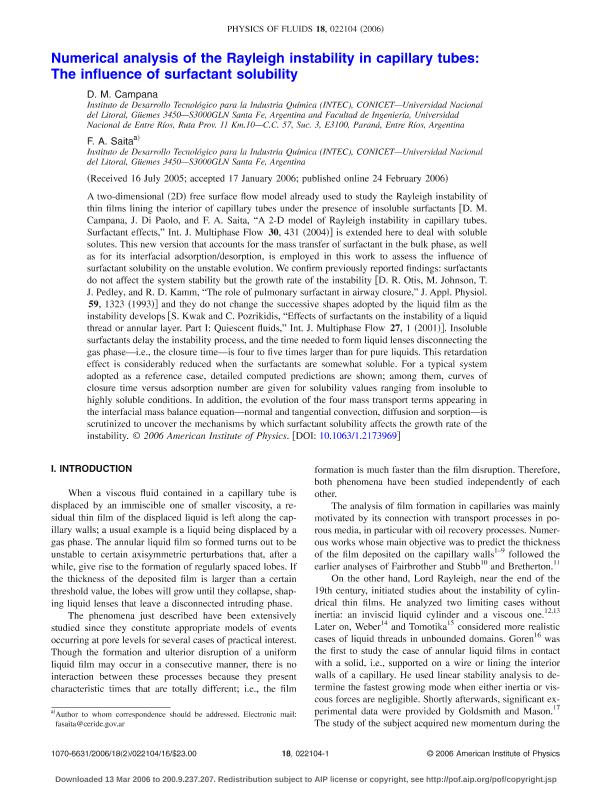Artículo
Numerical analysis of the Rayleigh instability in capillary tubes: The influence of surfactant solubility
Fecha de publicación:
12/2006
Editorial:
American Institute of Physics
Revista:
Physics of Fluids
ISSN:
1070-6631
Idioma:
Inglés
Tipo de recurso:
Artículo publicado
Clasificación temática:
Resumen
A two-dimensional (2D) free surface flow model already used to study the Rayleigh instability of thin films lining the interior of capillary tubes under the presence of insoluble surfactants [D. M. Campana, J. Di Paolo, and F. A. Saita, “A 2-D model of Rayleigh instability in capillary tubes. Surfactant effects,” Int. J. Multiphase Flow 30, 431 (2004)] is extended here to deal with soluble solutes. This new version that accounts for the mass transfer of surfactant in the bulk phase, as well as for its interfacial adsorption/desorption, is employed in this work to assess the influence of surfactant solubility on the unstable evolution. We confirm previously reported findings: surfactants do not affect the system stability but the growth rate of the instability [D. R. Otis, M. Johnson, T. J. Pedley, and R. D. Kamm, “The role of pulmonary surfactant in airway closure,” J. Appl. Physiol. 59, 1323 (1993)] and they do not change the successive shapes adopted by the liquid film as the instability develops [S. Kwak and C. Pozrikidis, “Effects of surfactants on the instability of a liquid thread or annular layer. Part I: Quiescent fluids,” Int. J. Multiphase Flow 27, 1 (2001)]. Insoluble surfactants delay the instability process, and the time needed to form liquid lenses disconnecting the gas phase—i.e., the closure time—is four to five times larger than for pure liquids. This retardation effect is considerably reduced when the surfactants are somewhat soluble. For a typical system adopted as a reference case, detailed computed predictions are shown; among them, curves of closure time versus adsorption number are given for solubility values ranging from insoluble to highly soluble conditions. In addition, the evolution of the four mass transport terms appearing in the interfacial mass balance equation—normal and tangential convection, diffusion and sorption—is scrutinized to uncover the mechanisms by which surfactant solubility affects the growth rate of the instability.
Palabras clave:
Rayleigh
,
Instability
,
Surfactant
Archivos asociados
Licencia
Identificadores
Colecciones
Articulos(INTEC)
Articulos de INST.DE DES.TECNOL.PARA LA IND.QUIMICA (I)
Articulos de INST.DE DES.TECNOL.PARA LA IND.QUIMICA (I)
Citación
Campana, Diego Martin; Saita, Fernando Adolfo; Numerical analysis of the Rayleigh instability in capillary tubes: The influence of surfactant solubility; American Institute of Physics; Physics of Fluids; 18; 2; 12-2006; 1-16
Compartir
Altmétricas




